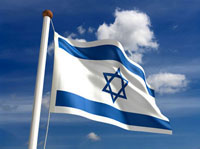The Israeli flag
 The Israeli flag still gives the Jews of the world a thrill when they see it at an international forum.
The Israeli flag still gives the Jews of the world a thrill when they see it at an international forum.
Only for Jews do the two stripes really resonate because of their origin in the tallit (the idea was that of David Wolffsohn, an early Zionist pioneer). Only to Jews does the Magen David really speak of historical experiences, hopes and tragedies.
Yet though it is said to have been David’s shield, made up of two dalets when drawn in the ancient triangular form, the Magen David was not an automatic choice.
Theodor Herzl wanted a gold flag with seven gold stars; the white background would stand for “our new and pure life”; the seven stars were “the seven working hours” that would symbolise the dignity of work. Later he modified his plan by placing the six stars on the six angles of the Magen David with the seventh above it.
It was all academic until the State actually came into being, but then too the Magen David was not adopted immediately. Amongst the suggestions made at that point were a menorah surrounded by seven stars or seven shofarot or even a combination of shofarot and etrogim.
National pride produced an alternative option – a menorah in the shape famous from the Arch of Titus in Rome, with some suggesting the addition of olive leaves on each side. This did become the basis of Israel’s coat of arms, but the search for a flag design continued.
Eventually the decision was made to go back to a flag used by the Chibbat Tziyyon movement – a white rectangle with a Magen David and a horizontal stripe top and bottom.
The result was a flag that proudly bears characteristic Jewish symbols, even though the scholars are still debating the question of how Jewish the Magen David really is and whether it was a recognisable Jewish symbol before the 17th century when the Prague and Vienna communities adopted it.



